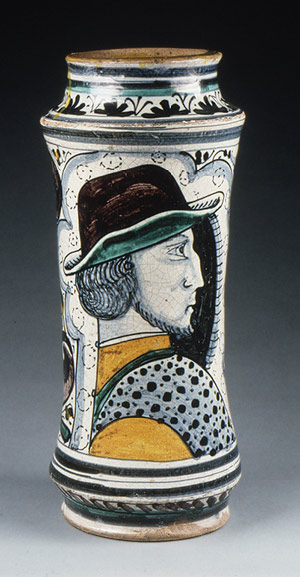Maiolica is
simply an old Italian word for pottery – specifically earthenware (as opposed to
red terracotta), with painted decoration on a white background under a
tin-based glaze. It is believed the term was first used to describe the
medieval lustre pottery from Spain that was imported into Italy via the island
of Mallorca. As the spirit or Renaissance spread through Italy during the 15th
century, maiolica potters in Tuscany, particularly those near Florence, took
the manufacture of pottery into a totally new dimension.
It is these early
pieces and, to a lesser extent, 17th and 18th-century
examples that interest collectors today. More affordable are 19th-century
copies of early master works predominantly pictured on the photos here – which have
just as much decorative potential without the high price tag.
Different
regions of Italy developed their own distinct styles of colour and ornament. Urbino
is best known for a style of painting called istoriato, where Bible stories or scenes from classical mythology
were brought to life in vibrant colours. Castel Durante is famed for dishes
painted with portraits of beautiful ladies, their names inscribed on a ribbon
behind. Faenza produced colourful borders, known as grotesques,
featuring mythical beasts among intricate ornament inspired by ancient Rome.
Lustre decoration in copper and golden tones was developed at Deruta,
while the best lustre decoration was added to Urbino dishes at Gubbio,
in the workshop of Maestro Giorgio.
All were
painstakingly hand-painted. The brushes were made from goat’s hair or even
mouse whiskers and pottery was too far costly to use for serving food. Instead,
the workshops focused on chargers, plaques and jars intended for display and to
show off one’s wealth. Those who could afford the sets of dishes – the Medicis,
Farneses, Gonzagas and other princely families of prosperous Italian cities –
displayed them proudly on cabinets in their palazzos. In 1532 the powerful
Pucci family of Florence commissioned an extensive set of plates and dishes
painted with scenes from classical mythology by one of the most important
painters in Urbino, Francesco Xanto
Avelli, who was also a poet.
The
expensive white tin-based glaze meant maiolica was out of the reach of ordinary
homes. It only could be admired in shops of the finest merchants or on the
walls of churches, where painted maiolica plaques and panels modelled in relief
became part of the richly decorated interiors. Many convents and monasteries
had pharmacies attached and these became the most important customers of the
maiolica potters - not least because the
splendid paintings in brilliant colours gave the jars a magicall quality.
People believed that medicine dispensed from such containers must surely cure
any ailment.
Sets of
pottery jars to contain medicines were arranged on shelves according to drug
names written n Latin script. Spouted ‘syrup jars’ contained remedies mixed
with sweet honey, while dry medicines and pills were kept in plain cylindrical
jars known as albarelli.
One of the
first maiolica collectors was Sir Andrew
Fountaine (1676 – 1753). His grand tour took him to Italy in 1701, where he
discovered what had then become known as ‘Raphael’s ware’. During subsequent
trips he bought fantastic pieces by Renaissance masters such as Xanto Avelli,
Maestro Giorgio and the artist known as the ‘In Castel Durante painter’. When the Fountaine collection was sold
in 1884, British aristocracy, newly wealthy industrialists and European museums
joined a bidding battle which raised a total of £91,112, the equivalent of several
million pounds today.
16th-century
maiolica is always costly, with superb examples selling for hundreds of
thousands of pounds. But later pieces, particularly those from the 19th
century, are more affordable. The designs are somewhat debased, but in a way
this adds to the folk charm that gives maiolica so much appeal. Nice 18th-century
plates can be found for as little as £200, while many drug jars and albarelli from north Italy o Sicily sell
for just a few hundred pounds.
A few workshops used marks and some masterpieces are
signed, but identifying marks on maiolica is something od a minefield. Even
three centuries ago dealers are said to have tried all sorts of tricks to cheat
Sir Andrew Fountaine. Maiolica fakes are more than plentyful and the best
Vicorian copy is almost impossible to tell apart from the real thing. So, if you
are inexperienced, buy from a specialist dealer or leading auction houses.





No comments:
Post a Comment